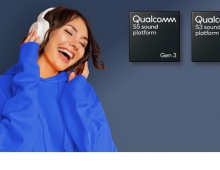
Regulators Approve AT&T's Purchase Of Qualcomm's 700 MHz Spectrum
AT&T said on Thursday that it won regulatory
approval to buy wireless spectrum from U.S. chipmaker
Qualcomm, a move that would boost the company's 4G
network.
That the U.S. Federal Communications Commission has
approved the sale of its Lower 700 MHz D and E Block
(Channel 55 and 56) unpaired U.S. spectrum licenses to
AT&T. The sale by Qualcomm to AT&T of the licenses for
$1.925 billion was originally announced in December,
2010. The proposed transaction has been pending subject
to the satisfaction of the conditions of closing.
In connection with the announcement of the transaction in 2010, AT&T indicated that, as part of its longer term 4G network plan, it intends to deploy this spectrum as supplemental downlink, using carrier aggregation technology. This new technology is designed to deliver capacity gains by enabling unpaired spectrum to be used in conjunction with paired spectrum for 4G services.
Qualcomm is integrating carrier aggregation technology into its chipset roadmap to enable supplemental downlink and intends to market the technology globally. This new technology is expected to create opportunities around the world in regions where unpaired spectrum bands can be made available for wireless operators to use in conjunction with existing paired bands in order to obtain substantial improvements in their mobile broadband networks.
"We are very pleased that the FCC has approved the sale of our spectrum licenses and look forward to working with AT&T to deploy supplemental downlink. This is a positive outcome for Qualcomm and our stakeholders," said Dr. Paul E. Jacobs, chairman and CEO of Qualcomm.
"We would like to express our appreciation to FCC Chairman Julius Genachowski, his fellow FCC Commissioners and the FCC staff. The use of supplemental downlink will enable the efficient use of unpaired spectrum for mobile broadband in the U.S. and a richer, faster mobile experience for consumers."
"This spectrum will help AT&T continue to deliver a world-class mobile broadband experience to our customers," Bob Quinn, an AT&T senior vice president, said in a statement.
The companies expect to close the transaction in the coming days, AT&T said.
In connection with the announcement of the transaction in 2010, AT&T indicated that, as part of its longer term 4G network plan, it intends to deploy this spectrum as supplemental downlink, using carrier aggregation technology. This new technology is designed to deliver capacity gains by enabling unpaired spectrum to be used in conjunction with paired spectrum for 4G services.
Qualcomm is integrating carrier aggregation technology into its chipset roadmap to enable supplemental downlink and intends to market the technology globally. This new technology is expected to create opportunities around the world in regions where unpaired spectrum bands can be made available for wireless operators to use in conjunction with existing paired bands in order to obtain substantial improvements in their mobile broadband networks.
"We are very pleased that the FCC has approved the sale of our spectrum licenses and look forward to working with AT&T to deploy supplemental downlink. This is a positive outcome for Qualcomm and our stakeholders," said Dr. Paul E. Jacobs, chairman and CEO of Qualcomm.
"We would like to express our appreciation to FCC Chairman Julius Genachowski, his fellow FCC Commissioners and the FCC staff. The use of supplemental downlink will enable the efficient use of unpaired spectrum for mobile broadband in the U.S. and a richer, faster mobile experience for consumers."
"This spectrum will help AT&T continue to deliver a world-class mobile broadband experience to our customers," Bob Quinn, an AT&T senior vice president, said in a statement.
The companies expect to close the transaction in the coming days, AT&T said.





















